'Nous avons foi au poison. Nous savons donner notre vie tout entière tous les jours.'
Arthur Rimbaud
------
Pascal was unique; just like everyone else.
He had his own stories, and his own dreams- though he'd never admit to his fears.
He had been many things in life, and saw the possibility of being yet many more.
For now, he was an agent of the law.
Not- as some believed or clung to- a Law with a capital 'L', that came from some divine or even scientific sanction; but the bastard mix of rules and consensus taboos that had been formed to both help and hinder the common man.
None of this particularly bothered, or warmed, Pascal.
He was out for himself, as he believed was everyone else, and though he wore the external costume of a faithful Catholic and liberal, 'Ni Dieu ni maître' pretty much summed up his position.
We've mentioned already the existence of stories and dreams (and denied our fears!),
and I suppose it might be wise to present an element of all three here....
......
When he escaped the Army; fled, Pascal assumed he would always be a man on the run.
Indeed, it was a number of years before he learned the sorry fate of his regiment, and was able to step out from the shadows of his fugitive lifestyle.
Not for the first time, a gut feeling or inner command had caused him to act in just the right way, at just the right time.
Some would call that a blessing, others luck- Pascal himself preferred to attribute everything good to himself, and everything bad to others- so he would settle for suspecting some kind of 'auto-providence' was involved.
He married the girl that was to bear him two blind sons out of a mix of lust and boredom, which many would call 'love'.
By this time, he was engaged in the respectable profession of an inn-keeper; which following his custom or inclination, he managed to do in an anything but respectable fashion.
Whilst his family would say that he'd been 'born bad', he just assumed that they had been 'born stupid', and unable to see the possibilities and the fun that could be had from going one's own way and playing one's own game.
Eventually, having amassed quite a large amount of money- and a larger amount still of enemies and police interest- he once again fled..............er, moved on in search of adventure.
The next, brief anecdote we will leave in the sensitive hands of one of his blind- and unnamed for the purposes of our narrative- sons...
......
My father was by turns an amusing and cruel man; sometimes both at the same time.
He is still infamous in the region, even all these years later.
He was a marvellous wit and raconteur, and one never knew to what degree his fabulous stories were true or mere inventions.
He actually didn't treat us badly; he kept us well-fed and comfortable, and even occasionally showed some interest in us as human beings, but generally he was cold and distant, and either holding something back or leaving people with the impression that that was the case.
A number of murders in the area have since been attributed to him, and it's certainly possible given his quick temper, love of action and definite sadistic streak.
Many a time did he punch or kick an unruly or rude patron into submission or unconsciousness.
He had studied the use of hands, feet, sticks, knives, swords and rifles in combat- and had at one time or other employed all of these on his fellow man.
His quick wits and tongue have passed on to serve myself well.
Apparently, I am also the spitting image of him- although clearly this I can never confirm...
The mental image I have of him may be something like the one that you, the reader, are forming in your head-
yet the image my father had of himself, only he will ever know.
...
'You are the finest police officer this station has ever known!', gushed the superintendant, still amazed that the gang had been brought down.
'How did you do it?', he continued, and then sensing a weighted silence, '.....no, of course! A great detective must have his secrets! ha ha Only natural. Please, take a......drink', he trailed off, seeing that Pascal was already pouring himself- but not the superintendant- a very large brandy.
...
I see the sentry posted out front, and equally note his boredom and fatigue.
He doesn't notice me.
I move to the dark corner just behind him, and watch and wait.
Soon, they arrive and enter with little fuss.
With the sentry's back turned to the street, I seize my moment.
My lead-filled truncheon needed to 'touch' the oaf's great head only twice- once where the spine meets the skull, and once just behind the ear- to put him beyond any immediate action.
When he awoke- if he awoke- he would have found the building in flames, and locked from the outside with his very own keys.
...
The newspapers tell of great things happening, of vast changes on the world stage.
I am an actor, who plays many parts- and my audience adores me; as well they should!
Before I take my bow, and before the final curtain of death descends,
does my dear reader have any requests?
...
'Plonger au fond du gouffre, Enfer ou Ciel, qu'importe ? Au fond de l'Inconnu pour trouver du nouveau !'
Charles Baudelaire
Pascal, many have said, was an artist.
Like a musician or a poet, he shaped and crafted situations and people, and left something more compelling and indeed more beautiful in his wake.
Heroes and villains are things for bad children's stories, I think- hence my living the way I do, and why my way/s of seeing the world have brought this 'Pascal' into imaginary existence.
Why must so many be happy to read or watch adventure and action tales, without ever seeking such experiences in their own lives?
Is it that they wish to live their lives 'by proxy'?
Will they remain in captivity, while imagining some kind of vicarious freedom?
That is Pascal talking; as I myself, the writer of this piece, am certainly no Anarchist!
...
The final act (of God, perhaps?).
An old man waits in his chair at home, knowing that his fate is coming.
In his hand- which is hidden behind his leg- a knife that has been sharpened and sharpened, ready for this very day.
Pascal's intuition is as sharp and accurate as ever, and when the door is thumped loudly, our protaganist rises from the chair, and takes an angle to the door, only seconds before it is kicked in.
The first man through is stabbed straight in the neck by Pascal, and the brute falls to his knees, trying hopelessly to stem the flow of life with his fingers.
The second assassin, hesitating for a split second, raises a metal bar far too obviously, and far too slowly.
Pascal circles off to the right to move with the blow, reducing its force like a boxer might.
He raises his left arm, wrapped in a thick coat, and barely feels any pain as the implement lands.
The enemy feels little pain either, as Pascal wraps the arm with the bar under his armpit, and repeatedly plunges the thirsty knife into the ribs and chest of his 'dance partner'.
The wretch clings desperately to Pascal, who releases the hold with a committed, sickening headbutt into his adversary's nose.
Pascal scans quickly, but sees no others.
He steps into the hallway, where one, simple discharge from a half-seen revolver ends his colourful life/story (aren't these the same thing?!) with little fanfare or mourning....
'Il ne faut jamais juger les gens sur leurs fréquentations ; Judas par exemple avait des amis irréprochables.'
Paul Verlaine













































